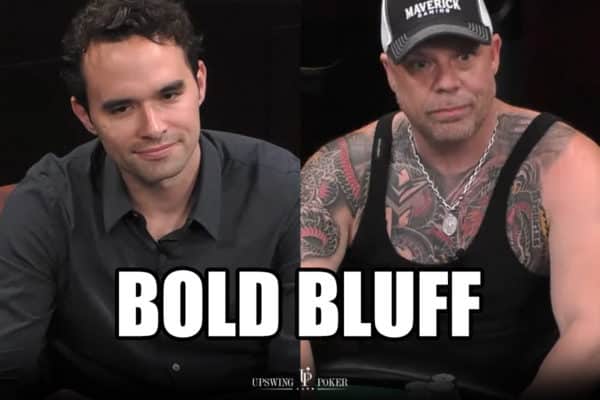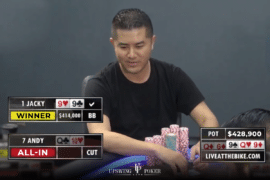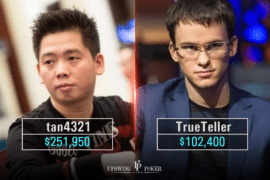
The $150,000 Bluff That Never Should Have Happened (Analysis)
Eric Persson and Alan Keating are two high-stakes poker players that have made quite a name for themselves over the past few years.
In the hand we’re about to review, the pair clashed horns in a colossal half-a-million-dollar pot. You just need to check out how this hand went down!
The blinds are $200/$400/$800 with a few extra straddles of $1,600 and $3,200. It comes from a pretty crazy game on a recent Hustler Casino Live show.
Let’s dive into the action!
Preflop Action
Persson started the hand with $237,000 in his stack and Keating covers, so they’re essentially playing 74 blinds (or straddles) deep.
Persson opens up the action from the third blind by raising to $18,200 with A♦ Q♠. Keating calls with 5♠ 5♣ from the final straddle.
Preflop Analysis
While AQ0 is a standard raise, Persson’s size of $18,200 is too large. He basically raised to 5.7x, which is way too big, especially with sub-100x stacks. A raise size of around $9,600-$10,000 would be more appropriate. That size would put a lot of hands in a tough spot in Keating’s shoes.
Against the very large raise, Keating can simply fold all of the weaker hands like Q6s, J7s, T7s, etc. He only has to continue with very strong hands (such as pocket pairs). Though, considering how Keating plays, he may still be calling those borderline hands.
Keating should be defending with a pretty tight range given that he needs around 38% equity in order for his call to be profitable. Hands such as pocket pairs work well because they are pretty easy to play on the flop. You either hit a set and continue or you don’t hit and then you fold (with some exceptions, of course).
Other playable hands are suited broadways, some of the stronger offsuit broadways such as AQ, AJ, KQ, and some of the Ax-suited hands such as A5s-A2s. It wouldn’t be crazy for Keating to set the trap and just call some monsters like AA–QQ and AK since the stack-to-pot ratio (SPR) won’t be high postflop, meaning it’s going to be easy to get all of the money in by the river.
Note: Learn step-by-step how to become the best player at the table when you join the Upswing Lab training course. Elite pros have been adding new content every week for the past four years, and you get all of it when you join. Learn more now!
Flop Action
The flop comes J♣ 5♦ 2♣ and the pot is $38,600.
Persson (A♦ Q♠) bets $20,000. Keating (5♠ 5♣) calls.
Flop Analysis
Persson should be checking very frequently with his range here. He could even consider checking 100% of the time. Even though he has more overpairs than Keating, his overall range is not that strong on this flop. He will have more hands that have missed compared to Keating’s range. This, coupled with the fact that he is out of position, makes it best to start by checking a lot on this flop.
A♦ Q♠ is an especially bad choice for bluffing since it doesn’t even have a club in it. The club is important because when the third club comes on the turn, he will block some flushes and can draw to a flush himself.
Persson’s decision to fire this loose flop bet set off an expensive ripple effect for him, as you’re about to see.
Even though he flopped a set, Keating is right to just call on the flop. Yes, there is a flush draw to worry a little bit about, but it’s a pretty dry board otherwise. The only other hands in Persson’s range with more than 4 outs are his low Ax-suited hands, which have a gutshot straight draw.
If the stacks were much deeper, raising would make more sense because otherwise it would be tough to win the maximum. But, as previously mentioned, the stack-to-pot ratio is very low (5.5) which means that Keating will have little trouble getting all the money in by the river.
Turn Action
The turn comes the 7♥, making the board J♣ 5♦ 2♣ 7♥. The pot is $78,600.
Persson fires a $50,000 double barrel. Keating calls.
Turn Analysis
The turn is a brick, completing no draws whatsoever. In this case, Persson should continue betting with a very polarized range.
I like the size Persson went with, but his hand selection is too ambitious. If he had a hand with more equity, like a flush or straight draw, barreling would make sense. His actual hand of AQo has very little chance of improving to the best hand on the river.
I will note that Persson’s hand does have some good blockers, making it a bit less likely Keating has AJ and QJ (both of which he would call with on the turn).
Keating makes the right move again by just calling with his set. There is no reason to raise when there is so little left behind and not a ton of draws possible. If the board had two flush draws and more potential open-ended straight draws, then raising to deny the equity of those hands is worth considering.
River Action
The river comes the 7♦, making the board J♣ 5♦ 2♣ 7♥ 7♦. The pot is still $179,000.
Persson goes all-in for $150,000. Keating snap-calls and wins a colossal $479,000 pot.
River Analysis
The river is a pretty neutral card, not favorable for either players’ range. This means that Persson should go all-in with hands such as:
- Sets (JJ, 55)
- Overpairs (AA-QQ)
- Top pair top kicker (AJ)
- Bluffs to balance those hands (like Ax Q♣, K♣ Qx, Kx Q♣)
Keep in mind that he shouldn’t bluff with all of those missed high card hands because then he’d be bluffing way too often considering his fairly snug value range.
Keating is simply smiling throughout the whole situation, and it’s hard to blame him. All he was thinking about was Vegas and the fucking Mirage.
Meanwhile, Persson had this look on his face:

The face of a man who just got snapped off
Final Thoughts
It’s awesome to see such splashy hands being played for such huge amounts of money. That may have been the easiest quarter million Keating will ever make at the poker table — he just had to say call 4 times and then stack the chips!
The hand should have played out very differently had Persson made the superior decision to check on the flop. Keating probably would have bet, and Persson may have folded or maybe he’d have decided to peel a card. Either way, it’s unlikely he would have torched that his entire $237,000 stack.
If you want more high stakes hand analysis, scroll down to “Related Posts” below.
Until next time, good luck, grinders!
Note: Ready to join 5,000+ players currently upgrading their No Limit Hold’em skills? Crush your competition with the expert strategies you will learn inside the Upswing Lab training course. Learn more now!









